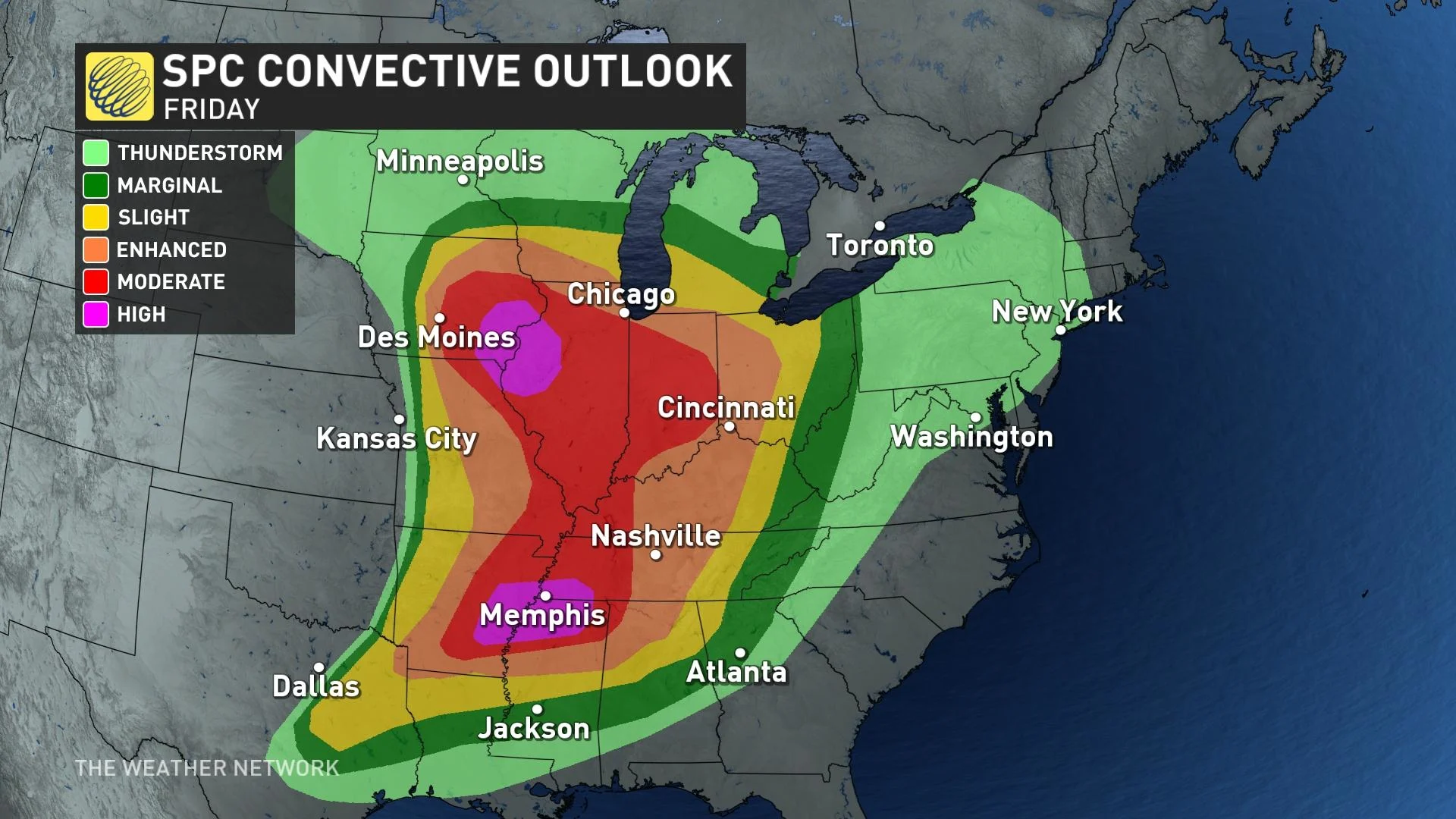
Violent tornadoes tear across U.S. during high-risk severe outbreak
A major severe weather outbreak across a large swath of the United States produced several large and powerful tornadoes on Friday.
“This is a particularly dangerous situation,” forecasters warned on Friday as a major severe weather outbreak unfolded across a large swath of the United States.
The U.S. Storm Prediction Center (SPC) issued a high risk for severe weather for two separate parts of the central U.S. on Friday, the highest category on the agency’s scale measuring the coverage and intensity of severe storms.
DON’T MISS: ‘This is a tornado emergency’: How forecasters warn of grave danger
Tornado watches stretched from southern Wisconsin to eastern Texas by early Friday evening, a 1,500-km expanse covering seven major cities and more than 27,000,000 people, including the cities of Chicago, St. Louis, and Memphis.

A Colorado low sweeping through the Upper Midwest created a setup for a classic, high-end severe weather outbreak across an enormous swath of the U.S.
This is such a dynamic system that parts of Iowa that saw strongly worded tornado watches early Friday afternoon found themselves under winter weather advisories by Friday night, expecting several centimetres of wind-driven snow.
The SPC strenuously warned that multiple “violent, long-lived” tornadoes were possible, along with widespread destructive wind gusts and hail the size of golf balls or larger.
This is the first high risk issued by the SPC since a significant tornado outbreak struck the southeastern states on March 25, 2021.
High risks are reserved for the most serious setups where forecasters expect multiple violent, long-lived tornadoes, or a destructive derecho similar to the one that struck Ontario and Quebec in 2022.
Violent tornadoes continued into Friday evening
A strong tornado caused extensive damage near Little Rock, Arkansas, on Friday afternoon, cutting a path through western and northern sections of the metro area.
“This is a tornado emergency for metro Little Rock,” the local National Weather Service office said as social media lit up with pictures of a large tornado churning up debris near the city.
Local officials reported widespread damage and the potential for significant injuries after the tornado. KTHV quoted local emergency officials who estimated there could be hundreds of injuries in the area in the wake of the storm, and Reuters reported that a local hospital received nearly two-dozen injured patients by Friday evening.
Farther north, multiple tornadoes touched down across southeastern Iowa near the centre of the low-pressure system itself. One particularly large tornado tore through farmland near the town of Ottumwa; the same storm went on to briefly produce two separate tornadoes at the same time.
While it’s rare, supercell thunderstorms can occasionally produce more than one tornado at the same time, especially after the thunderstorm regroups and begins to restrengthen after an encounter with stable air.
Severe risk pushes east overnight into Saturday
The threat for significant tornadoes is only one hazard from this multi-day severe thunderstorm outbreak.
After sunset on Friday, the individual thunderstorms producing intense tornadoes will likely merge into squall lines capable of producing widespread damaging winds of 120 km/h or greater.
These powerful lines of thunderstorms will affect Chicago, Indianapolis, Cincinnati, and Nashville overnight Friday into early Saturday morning, affecting travel by highway and air into the first half of the weekend.

MUST SEE: Watch? Warning? How we communicate severe weather in Canada
The cold front responsible for triggering much of the severe weather will push toward the East Coast during the day on Saturday, sparking a renewed threat for dangerous storms from Vermont to Florida.
These storms on Saturday will bring the threat for damaging winds and isolated tornadoes to much of the eastern states, including most of the Northeast and large sections of Interstate 95 and Interstate 81.
Severe weather season heating up in the U.S.
Friday’s severe weather outbreak is the latest in a spate of rough storms to hit the United States in recent days.
Last week, an intense EF-4 tornado swept through Mississippi’s Delta region, killing more than two-dozen people along the tornado’s 90+ km path.
Tornadoes are most common in the southeastern states between late March and late April, with activity migrating toward the Plains and traditional “tornado alley” in May and June.
WATCH: 'Tornado Alley' on the move as more twisters appear in eastern states
Contains files from KTHV and Reuters.
Thumbnail image courtesy of NOAA.











